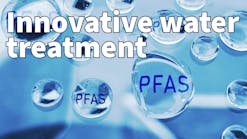As more tenured water operations employees retire, “there is a pressing need to recruit talent into the water industry to ensure the continued quality of our water,” notes Melanie Kennedy, senior vice president of human resources for American Water, the nation’s largest and most geographically diverse publicly traded water and wastewater utility company.
Case in point: Lindsey Olson, who recently was named operations superintendent for New Jersey American Water. Areas under Olson’s responsibility include a 10 mgd dissolved air floatation surface water treatment plant currently being expanded to 15 mgd, three iron removal treatment plants, 22 wells, 17 sewer lift stations, seven interconnects, and seven booster stations.
Throughout the years, Olson has worked on rehabilitation and expansion of existing facilities, as well as greenfield design and construction of new treatment plants. She has developed expertise in groundwater treatment technologies, including iron and manganese filtration systems, organics and radionuclide adsorption processes, and other trace contaminant removal technologies. Olson has taken on leadership positions in the New Jersey section and national board of American Water Works Association (AWWA) and contributed to its M-65 Manual for Onsite Generation of Sodium Hypochlorite, all while earning her master’s degree. As a young female engineer in the industry, Olson agrees that diversity is important in the water sector—be it gender, age, or ethnicity—in that “everybody brings another perspective.”
What She Does Day to Day
Olson is in the information-gathering part of her relatively new post with respect to the responsibilities of the two people who report to her and the 15 union employees reporting to them. She’s also learning about what her supervisors do. “I’m trying to help everybody be as efficient as possible and further improve on what we already have,” she says.
What Led Her to This Line of Work
Olson remembers being fascinated by bridges and tunnels while driving to visit her grandparents in Ohio. She earned a B.S. and M.S. in civil and environmental engineering at Rutgers University, where she switched from wanting to do structural design after finding her first structural engineering class not to her liking, to taking an environmental engineering class and conversing about the water industry with adjunct professor Steve Medlar, who had been senior vice president at CDM Smith. He told her about the largest waterborne disease in US documented history—the 1993 Cryptosporidiosis outbreak at a Milwaukee, WI, water purification plant.
“It was fascinating to me that I could be part of something to prevent people from needlessly dying or their health being impacted from something that shouldn’t be,” says Olson. “I realized how much we take water for granted. I wanted to be part of a group that doesn’t take it for granted.”
For the first five years with New Jersey American Water, Olson did project delivery, followed by 13 years in the corporate design group, utilizing Quality Assurance and Quality Control and serving as the liaison between consultants and operations. She enjoyed working in corporate operations for the opportunities it provided to work on different projects in its subsidiary operations in multiple states.
“I might do an iron removal plant in Long Island and one in Indiana, but Indiana’s project site might be 30 acres and the one in Long Island one acre, but the plant capacities might be very similar,” she notes. “It’s looking at the same issue from a different way or adding different constraints.”
What She Likes Best About Her Work
“In what I do, there’s always a different challenge,” she says. “If you can marry something that’s always a challenge with something that is in the public eye, it’s fun. My father is an electrical engineer and my mother was a gym and health teacher, so it’s like I meshed their professions together. I love that public health aspect of doing something good. It’s almost a calling.”
Trying to get people to understand “how interesting and cool this industry is and to attract people into it” is her greatest challenge, says Olson. She sees her AWWA involvement as an avenue for attracting students in STEM and vocational education programs and has invited interested students to visit her at her plant to learn more about the water sector.




